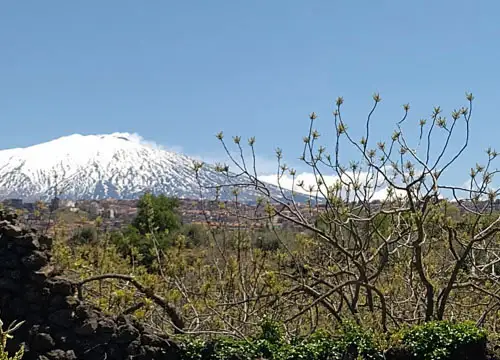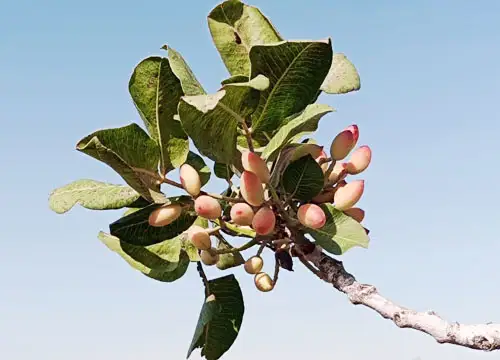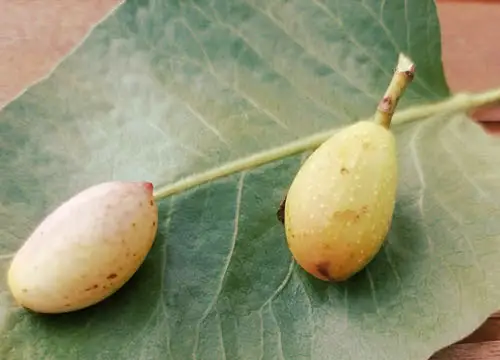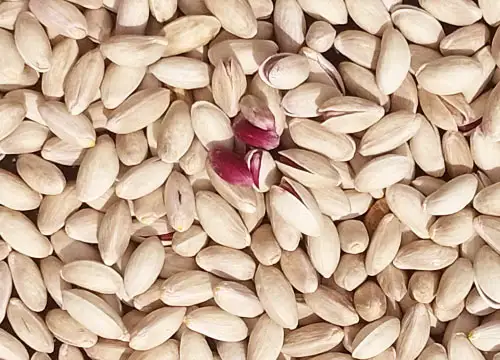Published:
Author: Antonio Maria Guerra
Bronte Pistachio PDO
HISTORY, INFO, PLACES, INTERESTING FACTS

On the slopes of Mount Etna, the Sicilian volcano that never stops muttering, there is a sun-kissed strip of land on which grows one of the treasures of the taste “Made in Italy”: the Bronte Green Pistachio, a product that can boast such characteristics as to have earned the appellation of Sicily’s ‘green gold’ and the PDO Mark. Let’s find out all its secrets, with the precious help of the Consortium of its most traditional producers.

What is Bronte Pistachio?
Bronte Pistachio PDO (Pistacchio Verde di Bronte DOP), is a variety of pistachio particularly prized, characterized by a deep green color and a rich, aromatic flavor. Characteristics of this kind are the fruit (it’s proper to say) of the combination of the volcanic soil, on which its plant grows and matures, with the local microclimate. Moreover, it’s impossible to forget the expertise of those who, over the centuries, have learned to make it grow: a skill that tastes of tradition.
The land of Bronte Pistachio.
According to the regulations governing its production, the plants of Bronte Green Pistachio PDO can be grown exclusively in the territory between the Italian municipalities of Bronte, Adrano and Biancavilla (Catania). Places of great charm, rich in history and tradition, that are located at the foot of Mount Etna, the Sicilian volcano.

The history of Bronte Pistachio.
As it’s quite often the case when dealing with Italian specialties, the origins of Bronte Pistachio are rooted in a very distant past.
Many researchers speculate that the plant was already present in Sicily during the classical period, when it was called ‘pistákion’ (πιστάκιον) and the island was part of Magna Graecia. However, it should be pointed out that its cultivation was perfected and developed only later, between the 9th and 11th centuries, by the Arabs: these had the great intuition of recognizing in the area on the slopes of Etna and its volcanic soil a perfect habitat.
It was at this point inevitable for pistachio to take root in the territories surrounding the municipalities of Bronte, Adrano, and Biancavilla (in the province of Catania), becoming a fundamental component of the local economy. Official recognition of this ‘excellence of taste’ finally came in 2009, when it was assigned the PDO mark, the Protected Designation of Origin.
Nowadays, Pistacchio Verde di Bronte DOP is one of the symbols of Sicilian gastronomy, an ingredient coveted by many of the most famous chefs from all around the world who use it in their food recipes, both sweet and savory.
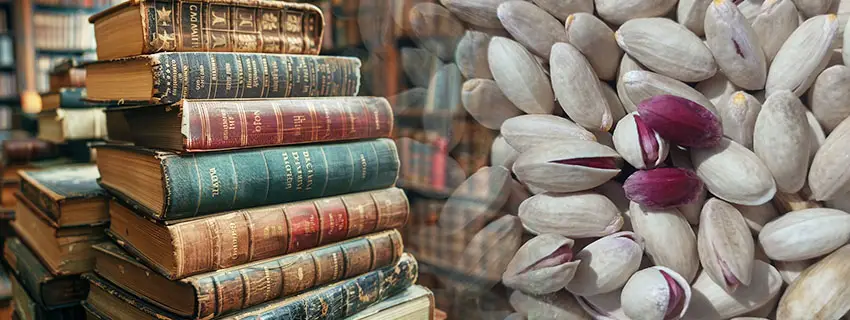
The origins of the name “Pistachio”.
The word ‘pistachio’ has an etymology that can best highlight the very ancient origins of the plant. Many scholars are almost certain that its birth should be traced back to a primitive Iranian dialect, in which the term “pistaka” (or “pista”) would have begun to be used. It later evolved into the “pistákion” (πιστάκιον) of the ancient Greeks and the “pistacium” of the Romans. Currently, many languages use the same root “pista-” to refer to both the plant and the fruit: from Italian “pistacchio” to French “pistache”, from English “pistachio” to Spanish “pistacho”.


The production of Bronte Pistacchio.
The production method of Bronte Pistacchio (Pistacchio Verde di Bronte) has remained almost unchanged for many centuries. Let’s give a look to the steps of this procedure:
The harvesting of the small fruits is performed by hand, shaking the plant or using rakes. It takes place every two years, generally between late August and early October.
Within a day from the harvesting, the so-called ‘smallatura’ is carried out: it’s a procedure typically performed by a machine that, thanks to rubbing and a flow of air, removes the fruit’s outer shell, the ‘hull’.
Once the hull is removed, the drying of the nuts is achieved by exposing them to the sun. This can take place either outdoors, in yards, or in special greenhouses, usually for a duration of about three days.
The dried pistachios are then stored in sacks, often made of jute, ready to be marketed. They are marketed with the shell or without it.
The harvest of Bronte Pistachio on video.
This fascinating video shows the harvesting of Bronte Pistachio, performed in one of the beautiful ‘pistacchieti’ at the foot of Mount Etna. Many thanks to the YouTube channel Agricola Fernanzez, author of the footage.


Bronte Pistachio in the kitchen.
Although Bronte Pistachio can be enjoyed plain, thus appreciating its original flavor and unique characteristics, this product is the perfect ingredient for a great number of gastronomic specialties, both sweet and savory. Here follow a couple of examples of these delicacies:

Pesto with Bronte Pistachio.
The pesto made with Bronte Pistachio is a cream including extra virgin olive oil, salt, and garlic (optional). Its consistency and flavor make it the ideal condiment for pasta and tasty ‘crostini’ (small pieces of toasted bread), through which it’s really possible to appreciate the aroma, tradition, and culture of the land of Sicily.

Bronte Pistachio sweet cream.
Bronte Pistachio cream is a specialty with a velvety texture and a deep green color, derived from that of the pistachio fruit. Its particular flavor comes from the combination of the sweetness of the sugar and the savory, aromatic taste of Sicilian pistachio. This delicacy gives its best when spread on bread or used for the filling of different kinds of desserts.
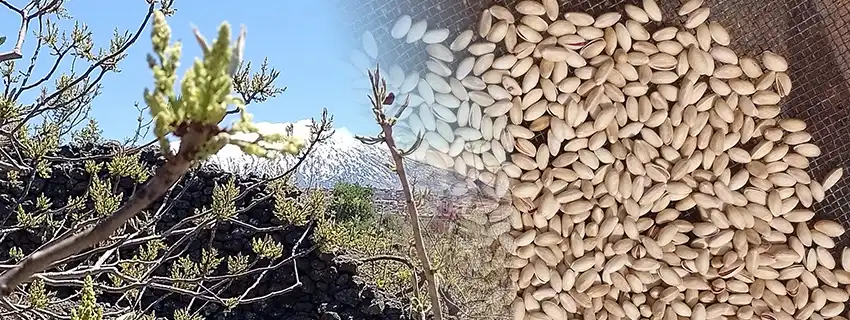
Bronte Pistachio: a Slow Food Presidium.
The Pistacchio Verde di Bronte grows on Etna’s volcanic soils, up to 800 meters above sea level: this allows it to acquire unique organoleptic characteristics but requires almost acrobatic manual harvesting among the lava boulders. The quality of the product and the (relatively) limited quantity available on the market have made it a Slow Food Presidium: a certification of excellence that, although not official, is widely recognized in the world of Italian food&wine.

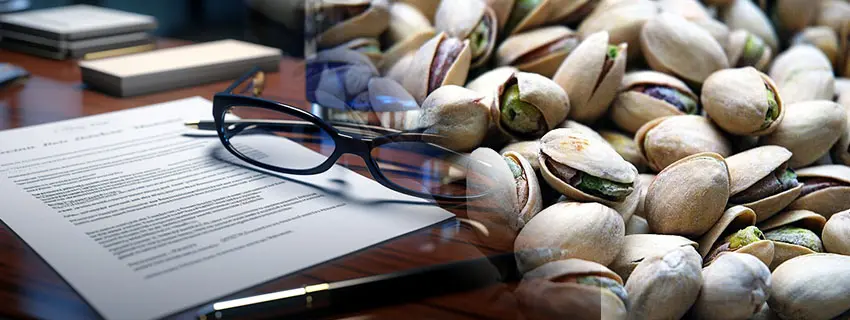
The Production Specification Document.
The production specification for Bronte Pistachio DOP (Pistacchio Verde di Bronte PDO) establishes strict rules to guarantee the authenticity and quality of the specialty. Here is a brief list of some of the main requirements:
Production area: the territories between the municipalities of Bronte, Adrano and Biancavilla (Catania);
Read more.
Variety of the plant: ‘Napoletana’;
- Characteristics of the soil: soil of volcanic origin;
Characteristics of the product: deep green color, elongated shape with a pointed end, sweet and aromatic flavor;
Harvesting: by hand, every two years, between the end of August and the end of September;
Packaging: to be carried out in the production area;
Labeling: the label must bear the PDO logo and the consortium logo;
More information can be found in the original document (in Italian launguage).
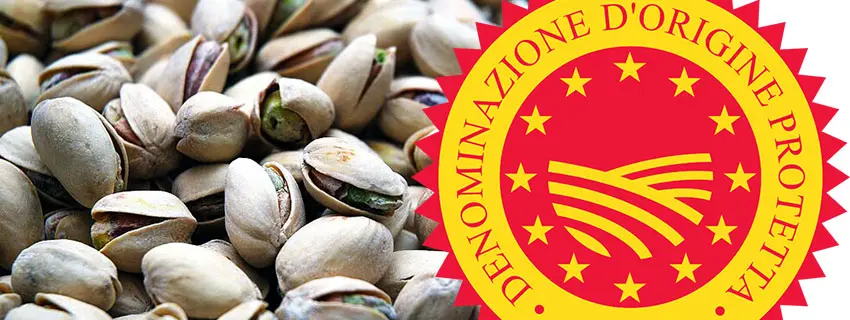
The PDO mark.
There is no doubt that the assignation of the PDO mark (Protected Designation of Origin) to the Bronte Green Pistachio in 2009 represented a moment of fundamental importance in the history of the product. This recognition has multiple functions, including the certification of the actual characteristics of the specialty, reached through strict compliance with the specification document. The ultimate goal is the defense of the consumer’s rights and the protection of the producers from the many attempts at imitation.
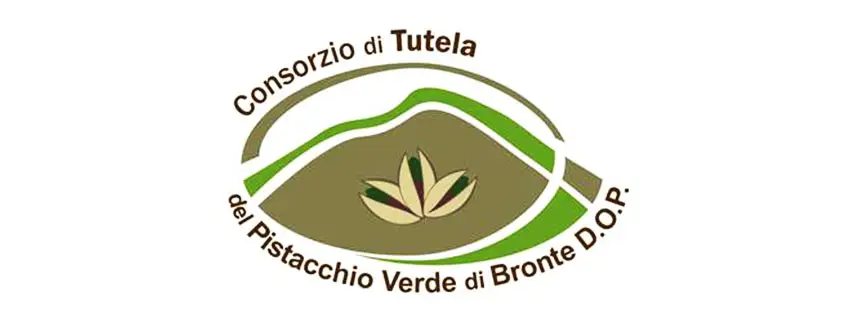
The Bronte Green Pistachio PDO Consortium.
The Bronte Green Pistachio PDO Consortium (Consorzio del Pistacchio Verde di Bronte DOP), to which the most traditional producers of the specialty belong, is in charge of the protection and promotion of the specialty. Here is some useful information about the association:
Contacts
Consorzio Basilico Genovese DOP.
Address: Via Leanza, 1 – Bronte (CT)
Official website: www.consorziopistacchioverdedibrontedop.it
Mail: info@consorziopistacchioverdedibrontedop.it
Tel.: +39 095 8838248
Copyright information.
The images displayed in this page belong to WebFoodCulture and to the Bronte Green Pistachio PDO Consortium, with the exception of:
Public Domain Images
- Logo DOP ;
Creative Commons Images
- “Pistacchio di Bronte appena raccolto” by Fabio Ingrosso from Italy is licensed under CC BY 2.0.
- “Pistachios meet Avocados” by Theo Crazzolara is licensed under CC BY 2.0.
- “Pistacia napoletana 1” by Hukketto is licensed under CC BY-SA 3.0.
- “Etna innevata Tremestieri Etneo” by Giuseppe Pappa is licensed under CC BY-SA 3.0.
- “Pesto di pistacchio di Bronte” by quest is licensed under CC BY-SA 2.0.
- “Crema di pistacchio” by Andrea Critti is licensed under CC BY 2.0.
- “Pistacchi” by Cemg is licensed under 3CC BY 3.0 Unported
- “Italy-2778 – Morning Etna” by archer10 (Dennis) is licensed under CC BY-SA 2.0.

